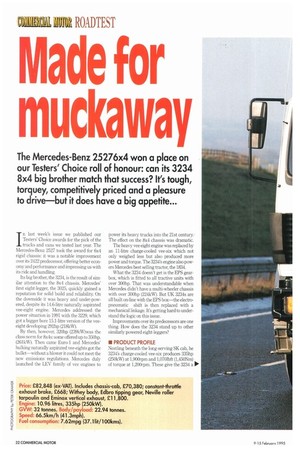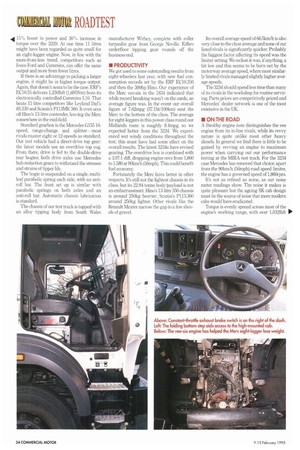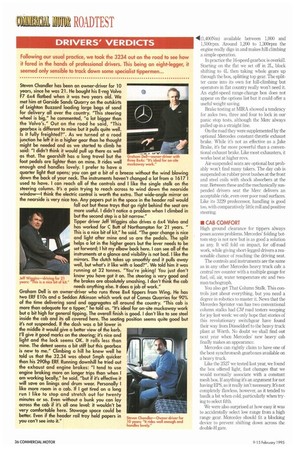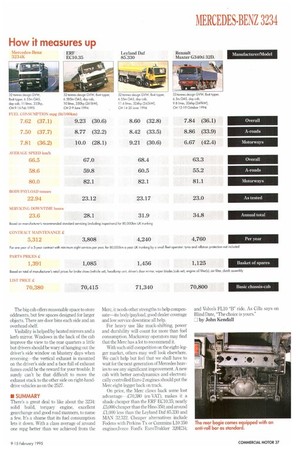Made for muckaway
Page 36

Page 38

Page 40

Page 41

If you've noticed an error in this article please click here to report it so we can fix it.
The Mercedes-Benz 25276x4 won a place on our Testers' Choice roll of honour: can its 3234 8x4 big brother match that success? It's tough, torquey, competitively priced and a pleasure to drive but it does have a big appetite...
In last week's issue we published our Testers' Choice awards for the pick of the trucks and vans we tested last year. The Mercedes-Benz 2527 took the award for 6x9 rigid chassis: it was a notable improvement over its 2422 predecessor, offering better economy and performance and impressing us with its ride and handling.
Its big brother, the 3234, is the result of similar attention to the 8x4 chassis. Mercedes' first eight-legger, the 3025, quickly gained a reputation for solid build and reliability On the downside it was heavy and under-powered, despite its 14.6-litre naturally aspirated vee-eight engine. Mercedes addressed the power situation in 1991 with the 3229, which got a bigger bore 15.1-litre version of the veeeight developing 292hp (218kW).
By then, however, 320hp (239kW)was the class norm for 8x4s: some offered up to 350hp. (261kW). Then came Euro-1 and Mercedes' hulking naturally aspirated vee-eights got the bullet—without a blower it could not meet the new emissions regulations. Mercedes duly launched the LEV family of vee engines to power its heavy trucks into the 21st century.. The effect on the 8x4 chassis was dramatic.
The heavy vee-eight engine was replaced by an 11-litre charge-cooled vee-six which not only weighed less but also produced more power and torque. The 3234's engine also powers Mercedes best selling tractor, the 1834.
What the 3234 doesn't get is the EPS gearbox, which is fitted to all tractive units with over 300hp. That was understandable when Mercedes didn't have a multi-wheeler chassis with over 300hp (224kW). But UK 3234s are all built on-line with the EPS box—the electropneumatic shift is then replaced with a mechanical linkage. It's getting hard to understand the logic on this issue.
Improvements over its predecessors are one thing. How does the 3234 stand up to other similarly powered eight-leggers?
• PRODUCT PROFILE Nestling beneath the long-serving SK cab, he 3234's charge-cooled vee-six produces 335hp (250kW) at 1,900rpm and 1,0701bft (1,450Nm) of torque at 1,200rpm. These give the 3234 a 0'
.4 15% boost in power and 30% increase in torque over the 3229. At one time 11 litres might have been regarded as quite small for an eight-legger engine. Now, in line with the more-from-less trend, competitors such as Iveco Ford and Cummins, can offer the same output and more from fewer litres.
If there is an advantage to picking a larger engine, it might be in higher torque output. Again, that doesn't seem to be the case. ERF's EC10.35 delivers 1,2501bft (1,695Nm) from its electronically controlled Cummins Lb. That beats 11-litre competitors like Leyland Dais 85.330 and Scania's P113114K 360. It even sees off Hino's 13-litre contender, leaving the Mere somewhere in the mid-field.
Standard gearbox is the Mercedes G155 16speed, range-change and splitter—most rivals muster eight or 12-speeds as standard. Our test vehicle had a direct-drive top gear: the latest models use an overdrive top cog. From there, drive is fed to the double-drive rear bogies; both drive axles use Mercedes hub-reduction gears to withstand the stresses and strains of tipper life.
The bogie is suspended on a single, multileaf parabolic spring each side, with an antiroll bar. The front set up is similar with parabolic springs on both axles and an anti-roll bar. Automatic chassis lubrication is standard.
The chassis of our test truck is topped with an alloy tipping body from South Wales manufacturer Withey, complete with roller tarpaulin gear from George Neville. Edbro underfloor tipping gear rounds off the business end.
• PRODUCTIVITY
We got used to some outstanding results from eight-wheelers last year, with new fuel consumption records set by the ERF EC10.350 and then the 300hp Hino. Our experience of the Merc vee-six in the 1834 indicated that while record breaking wasn't on the cards, an average figure was. In the event our overall figure of 7.62mpg (37.11it/100km) sent the Merc to the bottom of the class. The average for eight-leggers in this power class round our Midlands route is roughly 8.4 mpg, so we expected better from the 3234. We experienced wet windy conditions throughout the test; this must have had some effect on the overall results. The latest 3234s have revised gearing. The overdrive box is combined with a 3.97:1 diff, dropping engine revs from 1,860 to 1,580 at 90km/h (56mph). This could benefit fuel economy.
Fortunately the Merc fares better in other respects. It's still not the lightest chassis in its class, but its 22.94-tonne body/payload is not an embarrassment. Hino's 13-litre 350 chassis is around 250kg heavier; Scania's P113.360 around 250kg lighter. Other rivals like the Renault Maxter narrow the gap to a few shovels of gravel. Its overall average speed of 66.5km/h is also very close to the class average and none of our listed rivals is significantly quicker. Probably the biggest factor affecting its speed was the limiter setting. We reckon it was, if anything, a bit low and this seems to be born out by the motorway average speed, where most similarly limited rivals managed slightly higher average speeds.
The 3234 should spend less time than many of its rivals in the workshop for routine servicing. Parts prices are competitively priced and Mercedes' dealer network is one of the most extensive in the UK.
• ON THE ROAD A throbby engine note distinguishes the wee engine from its in-line rivals, while its revvy nature is quite unlike most other heavy diesels. In general we find there is little to be gained by revving an engine to maximum power when carrying out our performance testing at the MIRA test track. For the 3234 case Mercedes has removed that choice: apart from the 90km/h (56mph) road speed limiter, the engine has a governed speed of 1,860rpm.
It's not as refined as some, as our noise meter readings show. The noise it makes is quite pleasant but the ageing SK cab design must be the source of noise that more modern cabs would have eradicated.
Torque is evenly spread across most of the engine's working range, with over 1,0321bft
411 (1,400Nm) available between 1,000 and 1,500rpm, Around 1,200 to 1,300rpm the engine really digs in and makes hill climbing a simple operation.
In practice the 16-speed gearbox is overkill. Starting on the flat we set off in 2L, block shifting to 4L then taking whole gears up through the box, splitting top gear. The splitter came into its own for hill-climbing but operators in flat country really won't need it. An eight-speed range-change box does not appear on the options list but it could offer a useful weight saving.
Brake testing at MIRA showed a tendency for axles two, three and four to lock in our panic stop tests, although the Merc always pulled up in a straight line.
On the road they were supplemented by the optional Mercedes constant-throttle exhaust brake. While it's not as effective as a Jake Brake, it's far more powerful than a conventional exhaust brake. Like most exhausters, it works best at higher revs.
Air-suspended seats are optional but probably won't find many takers. The day cab is suspended on rubber pivot bushes at the front and steel coils with shock absorbers at the rear. Between these and the mechanically suspended drivers seat the Merc delivers an acceptable ride, even over poor road surfaces. Like its 3229 predecessor, handling is good too, with comparatively little roll and positive steering.
• CAB COMFORT High ground clearance for tippers always poses access problems. Mercedes' folding bottom step is not new but is as good a solution as any. It will fold on impact, for off-road work, while giving short-legged drivers a reasonable chance of reaching the driving seat.
The controls and instruments are the same as in any other Mercedes heavy truck cab: a central rev counter with a multiple gauge for fuel, oil, air, water temperature etc and twoman tachograph.
You also get That Column Stalk. This controls just about everything, but you need a degree in robotics to master it. News that the Mercedes Sprinter van has two conventional column stalks had CM road testers weeping for joy last week: we only hope that stories of this revolutionary switchgear have found their way from Dusseldorf to the heavy truck plant at Worth. No doubt we shall find out next year when Mercedes' new heavy cab finally makes an appearance.
Mercedes can rightly claim to have one of the best synchromesh gearboxes available on a heavy truck.
Like the 2527 we tested last year, we found the box offered light, fast changes that we would normally associate with a constant mesh box, If anything it's an argument for not having EPS, as it really isn't necessary ft's not completely flawless, however, as it tended to baulk a bit when cold, particularly when trying to select fifth.
We were also surprised at how easy it was to accidentally select low range from a high range gear. Mercedes should fit a blocking device to prevent shifting down across the double-H gate. The big cab offers reasonable space to store oddments, but few spaces designed for larger objects. There are door bins each side and an overhead shelf.
Visibility is helped by heated mirrors and a kerb mirror. Windows in the back of the cab improve the view to the rear quarters a little but drivers should be wary of hanging out the driver's side window on blustery days when reversing-the vertical exhaust is mounted on the driver's side and a face full of exhaust fumes could be the reward for your trouble. It surely can't be that difficult to move the exhaust stack to the other side on right-handdrive vehicles as on the 2527.
• SUMMARY
There's a great deal to like about the 3234: solid build, torquey engine, excellent gearchange and good road manners, to name a few. It's a shame that its fuel consumption lets it down. With a class average of around one mpg better than we achieved from the Mere, it needs other strengths to help compensate-its body/payload, good dealer coverage and low service downtime all help.
For heavy use like muck-shifting, power and durability will count for more than fuel consumption. Muckaway operators may find that the Mere has a lot to recommend it.
With such stiff competition on the eight-legger market, others may well look elsewhere. We can't help but feel that we shall have to wait for the next generation of Mercedes heavies to see any significant improvement. A new cab with better aerodynamics and electronically controlled Euro-2 engines should put the Mere eight-legger back on track.
On price, the Merc claws back some lost advantage-.00,380 (ex-VAT), makes it a shade cheaper than the ERF EC10.35; nearly £5,000 cheaper than the Hino 350; and around £1,000 less than the Leyland Daf 85330 and MAN 32.322. Cheaper alternatives include Foclens with Perkins Tx or Cummins L10 350 engines:Iveco Ford's EuroTrakker 320E34; and Volvo's FL10 "B" ride. As Cilia says on Blind Date, "The choice is yours." LJ by John Kendall


































































































